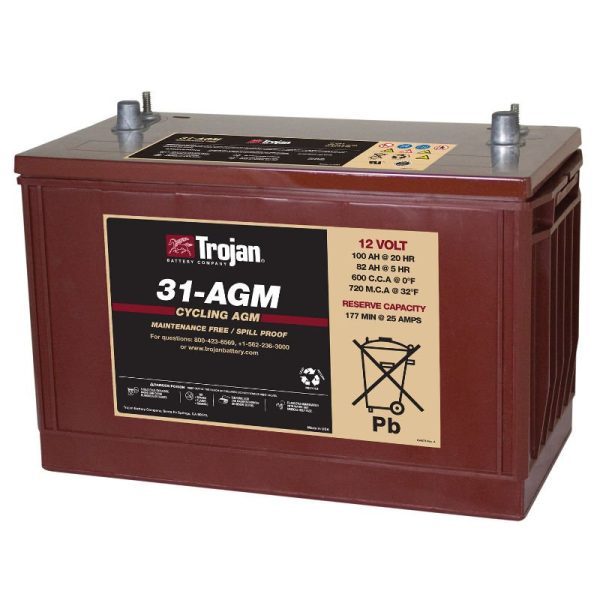
AGM battery - technology, advantages and disadvantages
Content
An uninterruptible power supply is needed for more than just activating the starter and starting the engine. The battery is also used for emergency lighting, the operation of the on-board system when the engine is turned off, as well as a short drive when the generator is out of order. The most common type of battery used in cars is lead acid. But they have several modifications. One of them is AGM. Let's discuss some modifications of these batteries, as well as their differences. What is special about the AGM battery type?
What is AGM Battery Technology?
If we conditionally divide the batteries, then they are divided into serviced and unattended. The first category includes batteries in which the electrolyte evaporates over time. Visually, they differ from the second type in that they have lids on top for each can. Through these holes, liquid deficiency is replenished. In the second type of batteries, it is not possible to add distilled water due to design features and materials that minimize the formation of air bubbles in the container.
Another classification of batteries concerns their characteristics. There are also two types of them. The first is starter, and the second is traction. Starter batteries have a large starting power and are used to start large internal combustion engines. The traction battery is distinguished by its ability to give off voltage for a long time. Such a battery is installed in electric vehicles (however, this is not a full-fledged electric car, but mainly children's electric cars and wheelchairs) and electrical installations that do not use high-power starting current. As for full-fledged electric cars such as Tesla, the AGM battery is also used in them, but as the basis for the on-board system. The electric motor uses a different type of battery. For more information on how to choose the right battery for your car, read in another review.
The AGM battery differs from its classic counterpart in that its case cannot be opened in any way, which means that it belongs to the category of maintenance-free modifications. In the process of developing maintenance-free types of AGM batteries, scientists were able to achieve a reduction in the amount of gases released at the end of charging. This effect became possible due to the fact that the electrolyte in the structure is in a smaller amount and in better contact with the surface of the plates.
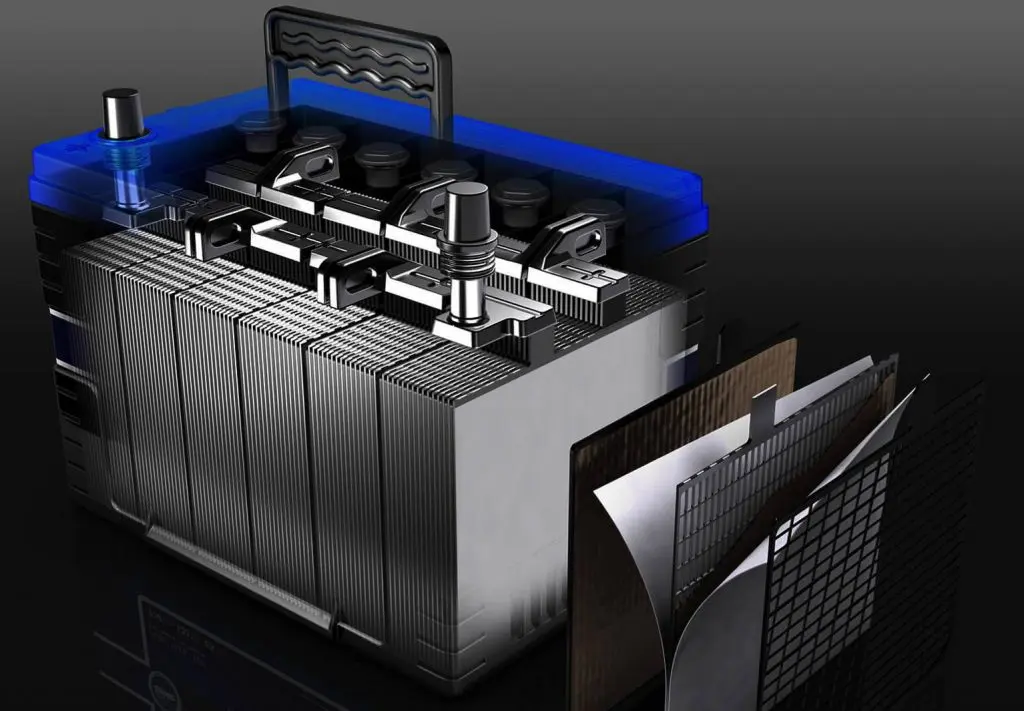
The peculiarity of this modification is that the container is not filled with free electrolyte in a liquid state, which is in direct contact with the plates of the device. The positive and negative plates are separated by an ultra-thin insulating material (fiberglass and porous paper) impregnated with an active acidic substance.
History of occurrence
The name AGM comes from the English "absorbent glass mat", which translates as an absorbent cushioning material (made of fiberglass). The technology itself appeared in the 70s of the last century. The company that registered the patent for the novelty is the American manufacturer Gates Rubber Co.
The idea itself came from one photographer who thought about how to reduce the rate of release of oxygen and hydrogen from the space near the plates. One option that came to his mind was to thicken the electrolyte. This material characteristic would provide better electrolyte retention when the battery was turned over.
The first AGM batteries rolled off the assembly line in 1985. This modification was mainly used for military aircraft. Also, these power supplies were used in telecommunication systems and signaling installations with an individual power supply.
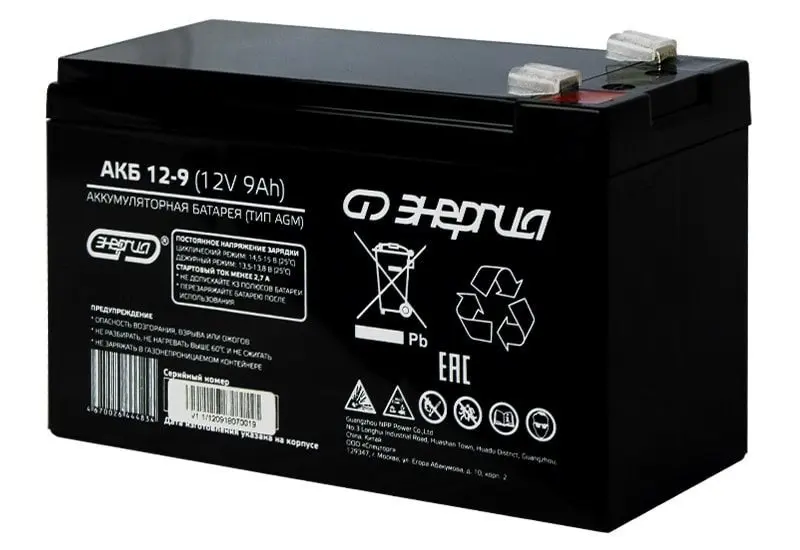
Initially, the battery capacity was small. This parameter varied in the range of 1-30 a / h. Over time, the device received an increased capacity, so that the installation was able to work longer. In addition to cars, this type of battery is used to create uninterruptible power supplies and other systems operating on an autonomous energy source. A smaller AGM battery can be used in computer UPS.
Principle of operation
A classic lead-acid battery looks like a case, divided into several sections (banks). Each of them has plates (the material from which they are made is lead). They are immersed in electrolyte. The liquid level must always cover the plates so that they do not collapse. The electrolyte itself is a solution of distilled water and sulfuric acid (for more details about the acids used in batteries, read here).
To prevent the plates from contacting, there are partitions made of microporous plastic between them. The current is generated between the positive and negative charge plates. AMG batteries differ from this modification in that a porous material impregnated with electrolyte is located between the plates. But its pores are not completely filled with the active substance. Free space is a kind of gas compartment in which the resulting water vapor is condensed. Due to this, the sealed element does not break when charging is in progress (when charging a classic serviced battery, it is necessary to unscrew the cans' caps, since at the final stage air bubbles can actively evolve, and the container can be depressurized).
With regard to the chemical processes taking place in these two types of batteries, they are identical. It's just that the batteries made using AGM technology are distinguished by their design and stability of operation (they do not need the owner to top up electrolyte). In fact, this is the same lead-acid battery, only thanks to the improved design, all the disadvantages of the classic liquid analogue are eliminated in it.
The classic device works according to the following principle. At the moment of consumption of electricity, the density of the electrolyte decreases. A chemical reaction takes place between the plates and the electrolyte, resulting in an electric current. When consumers have selected the entire charge, the process of sulfation of the lead plates begins. It cannot be reversed unless the density of the electrolyte is increased. If such a battery is put on charge, then, due to the low density, the water in the container will heat up and simply boil away, which will accelerate the destruction of the lead plates, therefore, in advanced cases, some add acid.
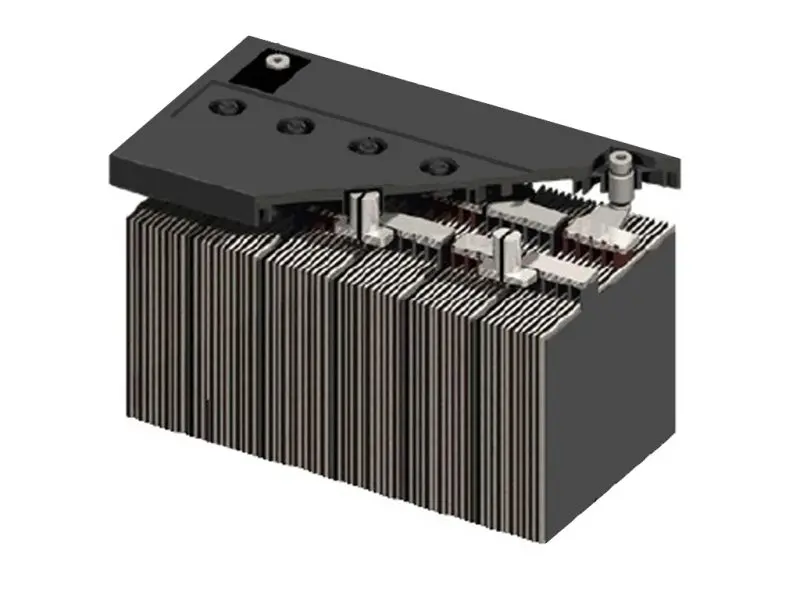
As for the AGM modification, it is not afraid of a deep discharge. The reason for this is the design of the power supply. Due to the tight contact of the glass fiber impregnated with electrolyte, the plates do not undergo sulfation, and the liquid in the cans does not boil. The main thing in the operation of the device is to prevent overcharging, which provokes increased gas formation.
You need to charge such a power source as follows. Typically, the device label contains manufacturer's instructions for minimum and maximum charging voltages. Since such a battery is very sensitive to the charging process, then a special charger should be used for this, which is equipped with a voltage change function. Such chargers provide a so-called "floating charge", that is, a portioned supply of electricity. First, a fourth of the nominal voltage is supplied (while the temperature should be within 35 degrees).
After the electronics of the charger fixes a certain amount of charge (about 2.45V per cell), the voltage reduction algorithm is triggered. This ensures a smooth end of the process, and there is no active evolution of oxygen and hydrogen. Even the slightest disruption to this process can significantly reduce battery performance.
Another AGM battery requires special use. So, you can store devices in absolutely any position. The peculiarity of these types of batteries is that they have a low self-discharge level. For one year of storage, the capacity can lose no more than 20 percent of its capacity (provided that the device was stored in a dry room at a positive temperature in the range of 5 to 15 degrees).
But at the same time, it is necessary to periodically check the charging level, monitor the condition of the terminals and protect it from moisture and dust (this can provoke a self-discharge of the device). For the safety of the power supply, it is necessary to avoid short circuits and sudden voltage surges.
AGM battery device
As we have already noticed, the AGM case is completely sealed, therefore such elements belong to the category of maintenance-free models. Instead of plastic porous partitions, there is porous fiberglass inside the body between the plates. These are separators or spacers. This material is neutral in electrical conductivity and interacts with acids. Its pores are 95 percent saturated with an active substance (electrolyte).
The fiberglass also contains a small amount of aluminum to reduce internal resistance. Thanks to this, the device is able to maintain fast charging and release energy when needed.
Just like a conventional battery, the AGM modification also consists of six cans or tanks with an individual set of plates. Each group is connected to the corresponding battery terminal (positive or negative). Each bank outputs a voltage of two volts. Depending on the type of battery, the plates may not be parallel, but rolled up. In this design, the battery will have a cylindrical can. This type of battery is highly durable and vibration-resistant. Another advantage in such modifications is that their discharge can produce a minimum of 500 and a maximum of 900A (in conventional batteries, this parameter is within 200A).
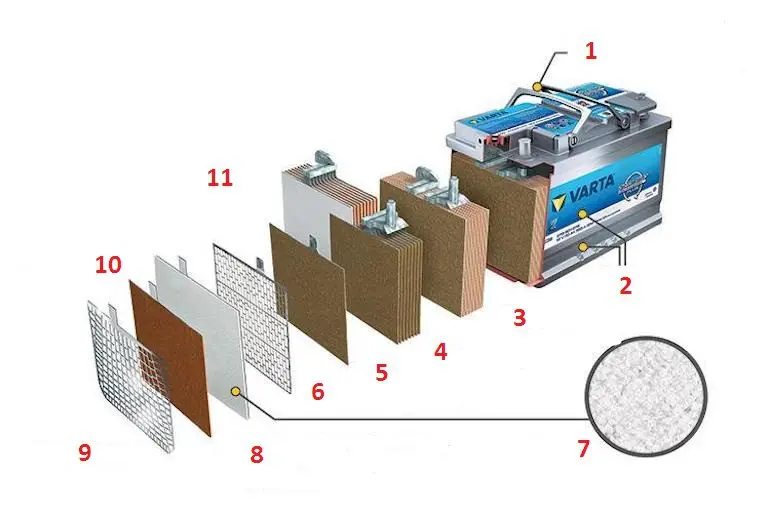
If we consider a classic battery, then charging provokes the formation of air bubbles on the surface of the plates. Because of this, the electrolyte is less in contact with lead, and this degrades the performance of the power supply. There is no such problem in the improved analogue, since the glass fiber ensures constant contact of the electrolyte with the plates. To prevent excess gas from causing a depressurization of the device (this happens when charging is not performed correctly), there is a valve in the body to release them. For more information on how to properly charge the battery, read separately.
So, the main design elements of AGM batteries are:
- Hermetically sealed case (made of acid-resistant plastic that can withstand constant vibrations with small shocks);
- Plates for positive and negative charge (they are made of pure lead, which may contain silicon additives), which are connected in parallel with the output terminals;
- Microporous fiberglass;
- Electrolyte (filling 95% of the porous material);
- Valves for removing excess gas;
- Positive and negative terminals.
What is holding back the spread of AGM
According to some estimates, around 110 million rechargeable batteries are produced in the world annually. Despite their greater efficiency compared to classical lead-acid counterparts, they occupy only a small share of the market sales. There are several reasons for this.
- Not every battery manufacturing company manufactures power supplies using this technology;
- The cost of such batteries is much higher than the usual types of devices (for three to five years of operation, it will not be difficult for a motorist to collect a couple of hundred dollars for a new liquid battery). They are usually two to two and a half times more expensive;
- A device with an identical capacity will be much heavier and more voluminous compared to a classic analogue, and not every car model allows you to place an enlarged battery under the hood;
- Such devices are very demanding on the quality of the charger, which also costs a lot of money. Classic charging can ruin such a battery in a matter of hours;
- Not every tester is able to determine the state of such a battery, therefore, to service an electrical source, you have to look for a specialized service station;
- In order for the generator to produce the voltage required for adequate recharging of the battery during operation, this mechanism will also have to be changed in the car (for details on how the generator works, read in another article);
- In addition to the negative effect of severe frosts, the device also does not tolerate high temperatures well. Therefore, the engine compartment must be well ventilated during the summer.
These reasons make motorists think: is it worth buying such a complex battery at all, if you can buy two simple modifications for the same money? Taking into account the needs of the market, manufacturers do not run the risk of releasing a large number of products that will simply gather dust in warehouses.
The main types of lead-acid batteries
Since the main market for batteries is the automotive industry, they are mainly adapted for vehicles. The main criterion by which a power source is selected is the total load of the entire electrical system and vehicle instruments (the same parameter applies to the selection of a generator). Since modern cars use a large amount of on-board electronics, many models are no longer equipped with standard batteries.
In some situations, liquid models are no longer able to cope with such a load, and AGM modifications can cope with this quite well, since their capacity can be two to three times higher than the capacity of standard analogs. Plus, some modern car owners are not ready to spend time servicing power supplies (although they do not require much maintenance).
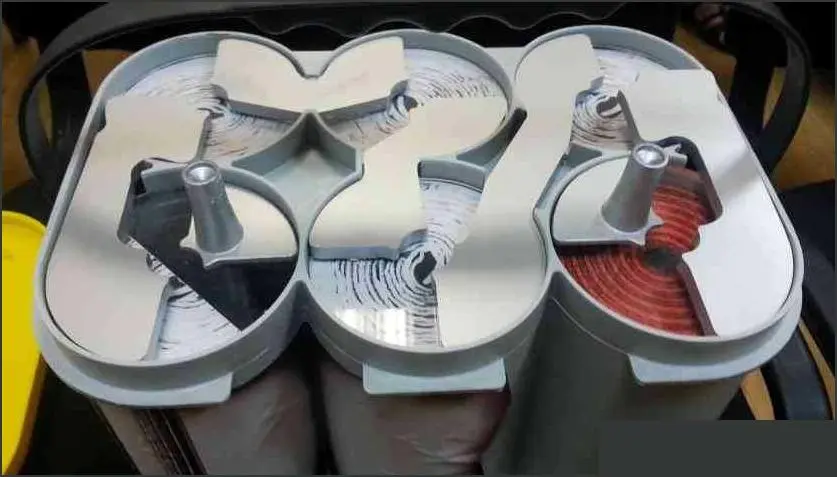
A modern car can use one of two types of batteries. The first is the maintenance-free liquid option. It uses calcium plates instead of antimony plates. The second is the analogue already familiar to us, made using the AGM technology. Some motorists confuse this type of battery with gel batteries. While they may look similar in appearance, they are actually different types of devices. Read more about gel batteries here.
As an improved analogue of the classic liquid battery, there are modifications made using EFB technology on the market. This is the same liquid lead-acid power supply, just for the sake of preventing sulfation of the positive plates, they are additionally wrapped in a porous material and polyester. This extends the service life of a standard battery.
Application of AGM batteries
AGM batteries are often used in cars equipped with start / stop systems, as they have an impressive capacity compared to classic liquid power supplies. But the automotive industry is not the only area in which AGM modifications are applied.
Various self-powered systems are often equipped with AGM or GEL batteries. As mentioned earlier, such batteries are used as a source of electricity for self-propelled wheelchairs and children's electric vehicles. In any case, an electrical installation with an individual uninterruptible power supply of six, 12 or 24 volts can take energy from this device.
The key parameter by which you can determine which battery to use is traction performance. Liquid modifications do not cope well with such a load. An example of this is the operation of an audio system in a car. The liquid battery can safely start the engine several times, and the radio tape recorder will discharge it in a couple of hours (for how to properly connect the radio tape recorder with an amplifier, read separately), although the power consumption of these nodes is very different. For this reason, classic power supplies are used as starters.
AGM battery benefits and technology
As already mentioned, the difference between AGM and classic batteries is only in design. Let's consider what are the advantages of the improved modification.
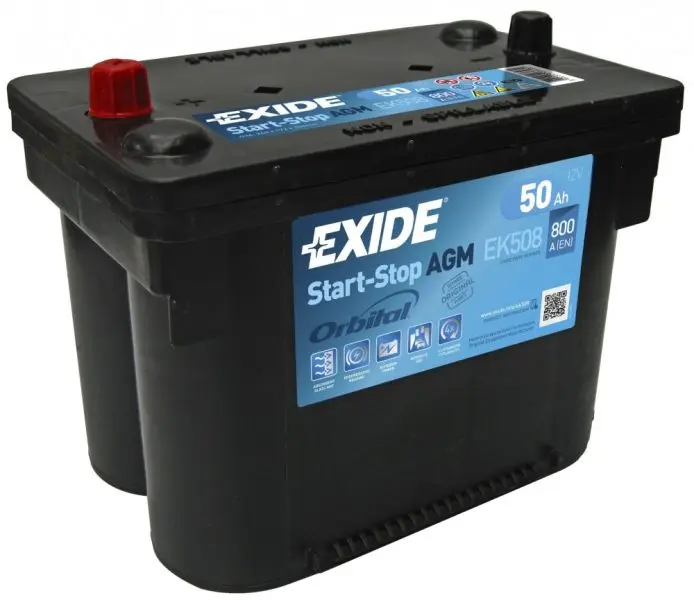
- Not afraid of deep discharges. Any battery does not tolerate a strong discharge, and for some modifications this factor is simply destructive. In the case of standard power supplies, their capacity is critically affected by frequent discharge below 50 percent. It is impossible to store the battery in this state. As far as AGM types are concerned, they tolerate about 20 percent more energy loss without serious harm compared to classic batteries. That is, repeatedly discharging to 30 percent will not affect battery performance.
- Not afraid of strong slopes. Due to the fact that the battery case is sealed, the electrolyte does not pour out of the container when it is turned over. The absorbed material prevents the working substance from moving freely under the influence of gravity. However, the battery must not be stored or operated upside down. The reason for this is that in this position, natural removal of excess gas through the valve will not be possible. The dump valves will be at the bottom, and the air itself (its formation is possible if the charging process is violated - overcharging or using a device that issues an incorrect voltage rating) will move up.
- Maintenance free. If the battery is used in a car, then the process of replenishing the electrolyte volume is not laborious and not harmful. When the lids of the cans are unscrewed, sulfuric acid vapors come out of the container in a small amount. For this reason, servicing classic batteries (including charging them, since at this moment the banks must be open) should be in a well-ventilated area. If the battery is operated in a residential environment, then such a device must be removed from the premises for maintenance. There are electrical installations that use a bundle of a large number of batteries. In this case, their operation and maintenance in a closed room is dangerous to human health, therefore, in such cases, batteries manufactured using AGM technology are used. The electrolyte evaporates in them only if the charging procedure is violated, and they do not need to be serviced throughout the entire working life.
- Not subject to sulfation and corrosion. Since the electrolyte does not boil or evaporate during operation and proper charging, the plates of the device are in constant contact with the working substance. Due to this, the process of destruction does not occur in such power sources. An exception is the same incorrect charging, during which the recombination of the evolved gases and the evaporation of the electrolyte are disturbed.
- Not afraid of vibrations. Regardless of the position of the battery case, the electrolyte is constantly in contact with the plates, since the fiberglass is tightly pressed against their surface. Due to this, neither small vibrations nor shaking provoke a violation of the contact of these elements. For this reason, these batteries can be safely used on vehicles that often drive over rough terrain.
- More stable at high and low ambient temperatures. There is no free water in the AGM battery device, which could freeze (during the crystallization process, the liquid expands, which is often the reason for the depressurization of the housings) or evaporate during operation. For this reason, the improved type of power supplies remains stable in frosts of -70 degrees and heat of +40 degrees Celsius. True, in cold weather, the discharge occurs as quickly as in the case of classic batteries.
- They charge faster and deliver a higher current in a shorter period of time. The second parameter is very important when cold starting the internal combustion engine. During operation and charging, such devices do not get very hot. To illustrate: while charging a conventional battery, about 20 percent of the energy is converted into heat, while in AGM versions this parameter is within 4%.
Disadvantages of batteries with AGM technology
Despite such a number of advantages, AGM-type batteries also have significant drawbacks, due to which the devices have not yet received widespread use. This list includes such factors:
- Although some manufacturers have set up mass production of such products, their cost is still twice as high as the classic analogue. At the moment, the technology has not yet received the correct improvements that would reduce the cost of products without sacrificing its performance.
- The presence of additional materials between the plates makes the design larger and at the same time heavier in comparison with liquid batteries of the same capacity.
- To properly charge the device, you need a special charger, which also costs decent money.
- The charging process must be monitored to prevent overcharging or incorrect voltage supply. Also, the device is very afraid of short circuits.
As you can see, AGM batteries do not have so many negative aspects, but these are significant reasons why motorists do not dare to use them in their vehicles. Although in some areas they are simply irreplaceable. An example of this are large electrical units with an individual uninterruptible power supply, storage stations powered by solar panels, etc.
At the end of the review, we offer a short video comparison of three battery modifications:
Questions and answers:
What is the difference between AGM and a regular battery? The AGM is even heavier from a conventional acid battery. It is sensitive to overcharge, you need to charge it with a special charge. AGM batteries are maintenance-free.
Why do you need an AGM battery? This power supply does not require maintenance, therefore it is more convenient to use on foreign cars. The design of the battery case allows it to be installed vertically (sealed case).
What does the AGM label on the battery mean? It is an abbreviation of the modern lead acid power supply technology (Absorber Glass Mat). The battery is in the same class as the gel counterpart.
